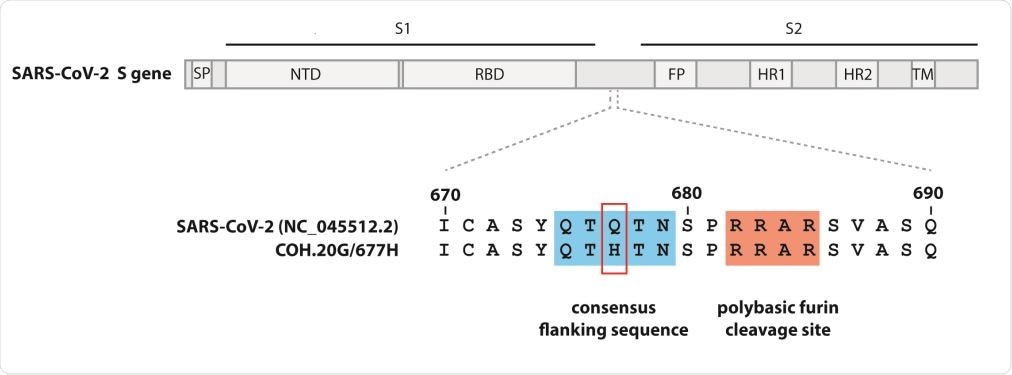Genomic sequencing of severe acute respiratory syndrome coronavirus 2 (SARS-CoV-2) has facilitated tracking shifts in viral isolates globally.
The emergence of the D614G mutation gave rise to the more transmissible G‐strain of SARS-COV-2. Studies show that this variant has increased cell binding and viral transmission within in vitro models. More distinct SARS‐CoV‐2 strains with additional changes have emerged over the last few months, rapidly spreading in the United Kingdom.
These variants contain many distinct mutations in the spike (S) gene, particularly N501Y. The rapid transmissibility and the sudden changes to the S gene have raised concerns about changes in the pattern of disease and the potential variability in how COVID-19 patients respond to vaccines or antibody therapies.

 *Important notice: bioRxiv publishes preliminary scientific reports that are not peer-reviewed and, therefore, should not be regarded as conclusive, guide clinical practice/health-related behavior, or treated as established information.
*Important notice: bioRxiv publishes preliminary scientific reports that are not peer-reviewed and, therefore, should not be regarded as conclusive, guide clinical practice/health-related behavior, or treated as established information.
SARS‐CoV‐2 genomic surveillance in Columbus, Ohio, reveals a parallel shift in the 20C>20G clade with 3 new variants
Recently researchers from the United States reported the results of a SARS‐CoV‐2 genomic surveillance conducted between April 2020 and January 2021 in Columbus, Ohio. Their work is released as a preprint on the bioRxiv* server.
The study's data reveals a recent parallel shift in the predominant 20C>20G clade with 3 new variants. It also shows the presence of a novel viral isolate with the S N501Y variant but is different from the UK‐B.1.1.7 (20I/501Y.V1) and the South African (20H/501Y.V2) variant.
"The same N501Y mutation was subsequently found in a clade 20C strain in South Africa, where it was associated with a different set of additional S variants, with Next Strain designation as 20H/501Y.V3."
One of these isolates has become the predominant virus detected in nasopharyngeal swabs between December 2020 and January 2021 and has S p.Gln677His, membrane glycoprotein (M) p.Ala85Ser (Q677H), and nucleocapsid (N) p.Asp377Tyr (D377Y) mutations. The other isolate has S N501Y and ORF8 Arg52Ile (R52I), the two markers of the UK‐B.1.1.7 strain but lacks all other virus mutations. It shares multiple mutations with the clade 20C/G viruses present in Ohio before December 2020. These two viruses currently emerging in the US add to the diversity of Spike gene changes worldwide and support several independent acquisitions of S N501Y during this pandemic phase.

Site of the Q677H mutation in Spike gene in the QTQTN motif conservation/furin cleavage site. Signal peptide (SP), N‐terminal domain (NTD), receptor‐binding domain (RBD), fusion peptide (FP), heptad repeat 1 (HR1), heptad repeat 2 (HR2), and transmembrane domain (TM).
The rapid emergence of N Asp377Tyr mutation merits closer attention
The researchers report the presence of a viral isolate from December 2020 in Columbus, Ohio that has acquired the S N501Y variant. This amino acid change was first found in a clinical sample in the UK along with other novel spike variants and a clade 20B backbone. The combination has been named as the B.1.1.7 strain and a NextStrain designation as 20I/501Y.V1. The same N501Y mutation was subsequently found in a South African clade 20C strain associated with a different set of additional S variants.
"In late December, we detected a single sample with a 20G strain backbone that had acquired S N501Y and ORF8 R52I mutations (designated COH.20G/501Y, Figure 1, arrow), which are both present in the UK‐B.1.1.7 strain."
The incidence of both these variants started to increase markedly in late December 2020 and the S 501Y mutation was deemed to be the reason behind the increased transmissibility. The virus with the S N501Y mutation found in Columbus (COH.20G/501Y) has a 20G backbone but lacks most of the reported consensus changes in 20I/501Y.V1 and 20H/501Y.V2.
They also report the emergence of a predominant SARS‐CoV‐2 virus variant with a 20C/G clade backbone and single mutations in the S, M, and N genes in Columbus, Ohio, in December 2020. The N677H mutation affects a QTQTN consensus sequence adjacent to the polybasic furin cleavage site spanning the S1 and S2 junction. It has only been rarely reported in NextStrain and other publications. Studies have reported deletions spanning the QTQTN motif that may influence viral properties. According to the authors, the N Asp377Tyr mutation has not been reported much previously, and its rapid emergence merits closer attention.
"We also report the emergence of a predominant SARS‐CoV‐2 virus population with a 20C/G clade backbone that has single mutations in the S, M and N genes (Gln677His, p.Ala85Ser, and p.Asp377Tyr, respectively) in Columbus, Ohio in December."

 *Important notice: bioRxiv publishes preliminary scientific reports that are not peer-reviewed and, therefore, should not be regarded as conclusive, guide clinical practice/health-related behavior, or treated as established information.
*Important notice: bioRxiv publishes preliminary scientific reports that are not peer-reviewed and, therefore, should not be regarded as conclusive, guide clinical practice/health-related behavior, or treated as established information.
Journal reference:
- Preliminary scientific report.
Distinct Patterns of Emergence of SARS-CoV-2 Spike Variants including N501Y in Clinical Samples in Columbus Ohio, Huolin Tu, Matthew R Avenarius, Laura Kubatko, Matthew Hunt, Xiaokang Pan, Peng Ru, Jason Garee, Keelie Thomas, Peter Mohler, Preeti Pancholi, Dan Jones bioRxiv 2021.01.12.426407; doi: https://doi.org/10.1101/2021.01.12.426407, https://www.biorxiv.org/content/10.1101/2021.01.12.426407v1